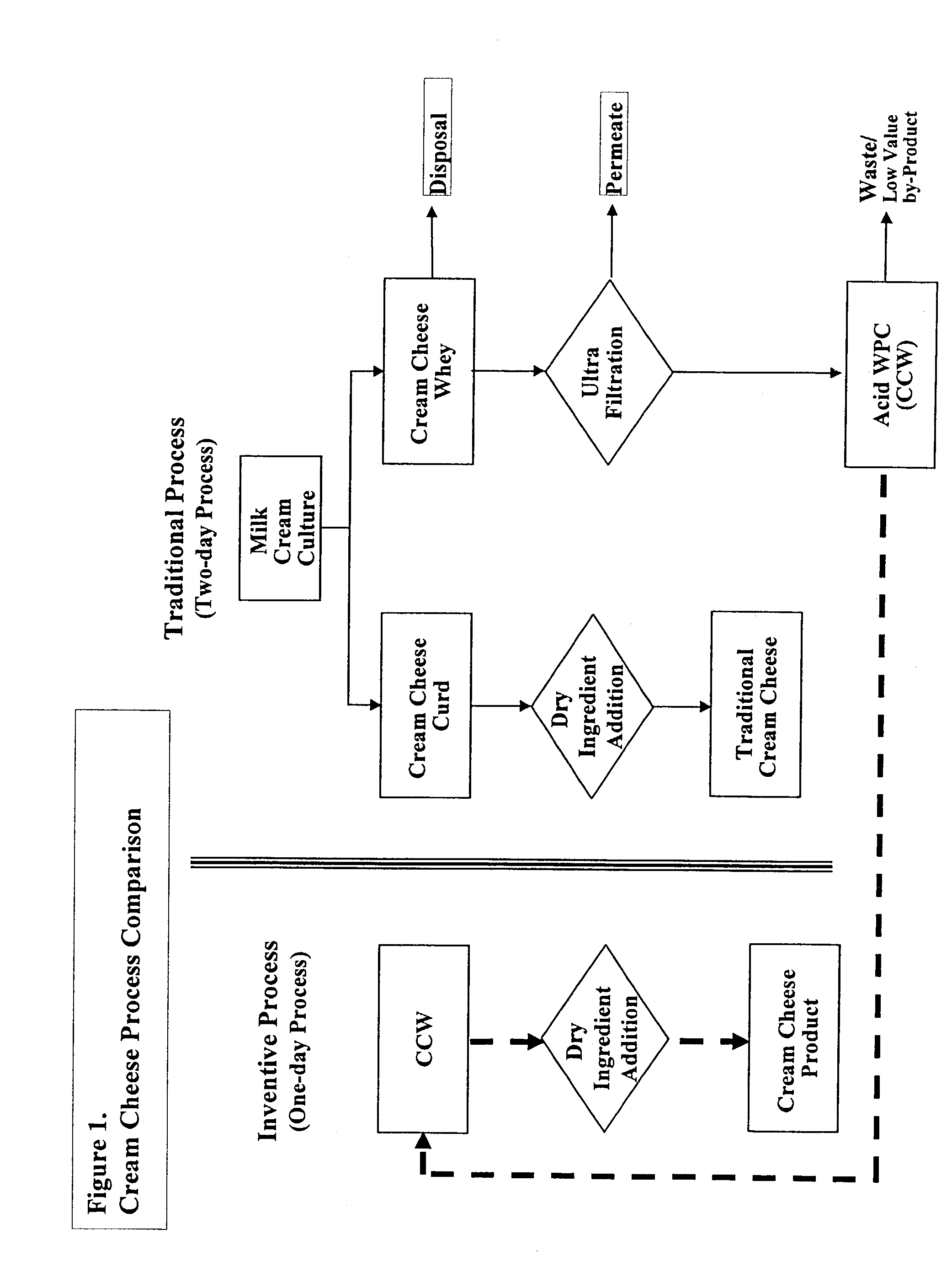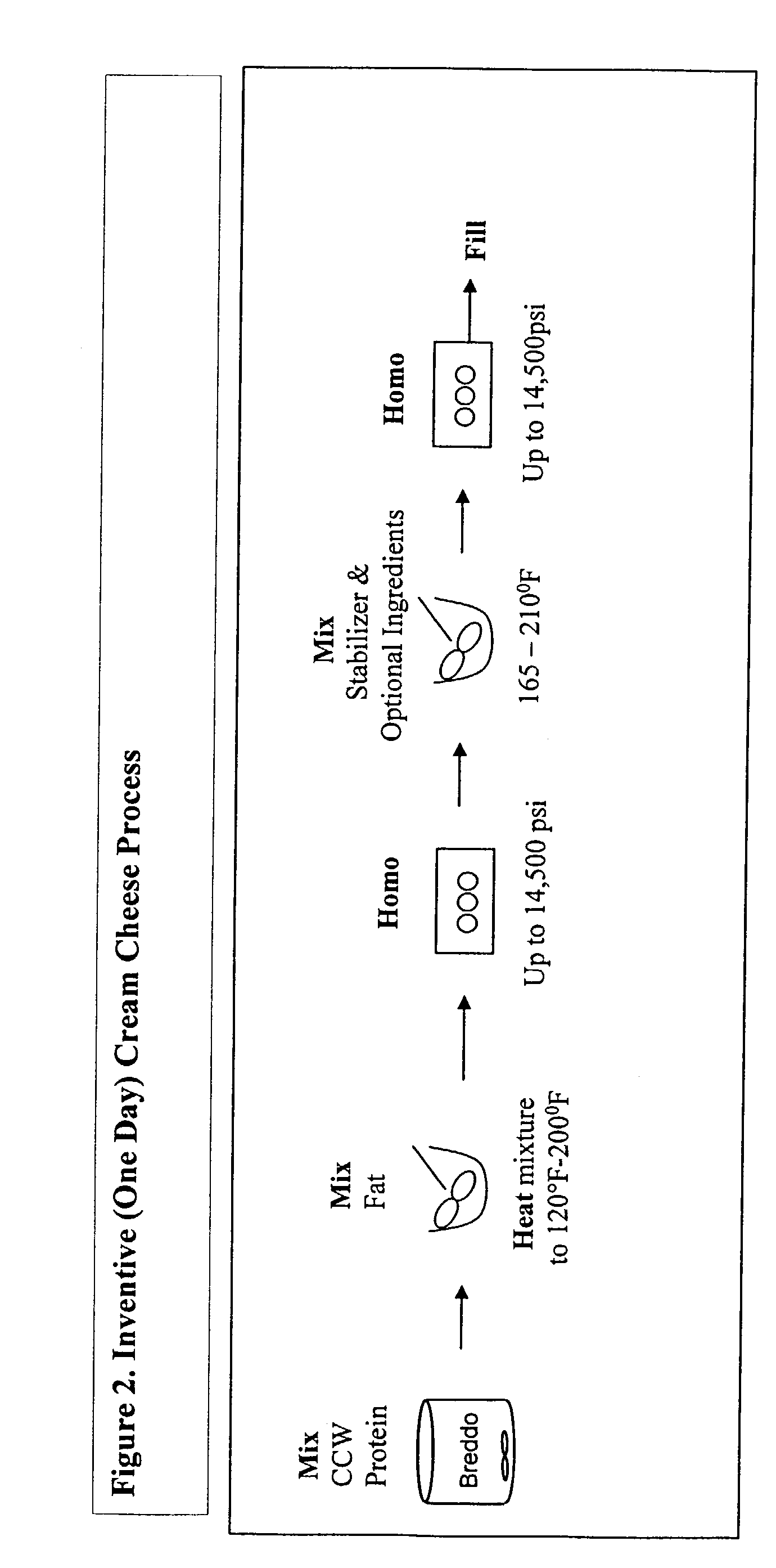Acid whey texture system
a texture system and whey technology, applied in the field of acid whey texture system, can solve the problems of high cost of commercial whey drier, high cost of whey, and general labor-intensive process of cheese, and achieve the effect of convenient and economical us
- Summary
- Abstract
- Description
- Claims
- Application Information
AI Technical Summary
Benefits of technology
Problems solved by technology
Method used
Image
Examples
example 1
[0044]This example demonstrates at the lab scale that a cream cheese-like product can be made directly from CCW without culturing step or addition of curd.
[0045]Concentrated Cream Cheese Whey (CCW) (77% moisture content, 10.3% fat, 7.4% protein, 2.54% lactose having a pH 4.2) was homogenized in a high pressure homogenizer (Cavipro brand homogenizer) at 5,000 psi or at 10,000 psi with incorporation of 0%, 10% or 20% anhydrous milk fat (AMF), with the percent relating to the total weight of the product to obtain a homogenate. The homogenization was conducted at 140° F. The homogenate was heated in a small lab heating / cooling device with gentle continuous mixing (a rapid viscograph analyzer, “RVA”, from Newport Scientific) at a heat rate sufficient to achieve about 57° F. / min until about 185° F. was reached, and the temperature was maintained for about 30 minutes, before being cooled down to about 86° F. Apparent viscosity was continuously monitored during the heating and cooling cycle...
example 2
A Cream Cheese-like Product was Made at the Lab-bench.
[0047]The following ingredients were used: 13.77% anhydrous milk fat (AMF), 75% liquid concentrated acid cream cheese whey (CCW, 88.6% mosiutre, 1.37% fat, 3.7% protein, 4.2% lactose), 4.7% of a WPC 34 (WPC 34 from Wisconsin Whey International, Wis.), 4.31% WPC 8000,1.% of a maltodextrin (C-delight® MD 01970 brand maltodextrin), 0.05% of xanthan gum, 0.36% of a carob gum, 0.78% salt (NaCI), and 0.03% of sorbic acid.
[0048]A product having a higher yield stress was produced as follows using the foregoing ingredients. The CCW and anhydrous milk fat (AMF) were separately preheated to approximately 110F. The WPC 34 and WPC 8000 were mixed. The pH was about 4.85 to 4.86. The warmed AMF was added to the WPC mixture and mixed for about a minute or so to obtain a coarse mixture. The coarse mixture was heated in a Stepan cooker at a temperature of up to about 140° F. The slurry that was obtained was homogenized at a pressures of 3000 psi a...
example 3
[0050]Products having firmer texture were obtained by adding the gum(s), maltodextrin, and salt after the first homogenization. The general method was similar to Example 2, but the first homogenization was conducted at 10,000 psi, the second-heating step was conducted at about 180° F. for about 20 minutes, and the second homogenization was conducted at 3,500 psi. The product formulation was as follows (% are weight percent):
[0051]
INGREDIENT%AMF13.11CCW75.05FDA 509.62Sorbic Acid0.03Salt0.78C-Delight MD ® 019701.00Carob0.36Xanthan0.05Finished Product100.00
PUM
 Login to View More
Login to View More Abstract
Description
Claims
Application Information
 Login to View More
Login to View More - R&D
- Intellectual Property
- Life Sciences
- Materials
- Tech Scout
- Unparalleled Data Quality
- Higher Quality Content
- 60% Fewer Hallucinations
Browse by: Latest US Patents, China's latest patents, Technical Efficacy Thesaurus, Application Domain, Technology Topic, Popular Technical Reports.
© 2025 PatSnap. All rights reserved.Legal|Privacy policy|Modern Slavery Act Transparency Statement|Sitemap|About US| Contact US: help@patsnap.com


